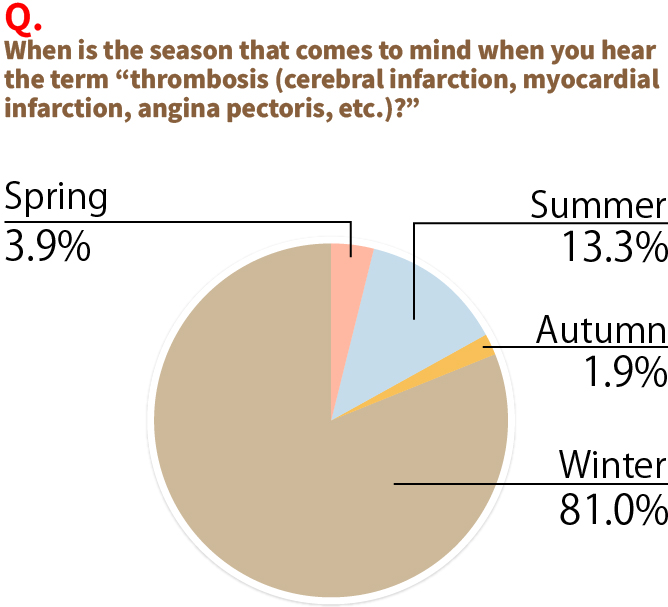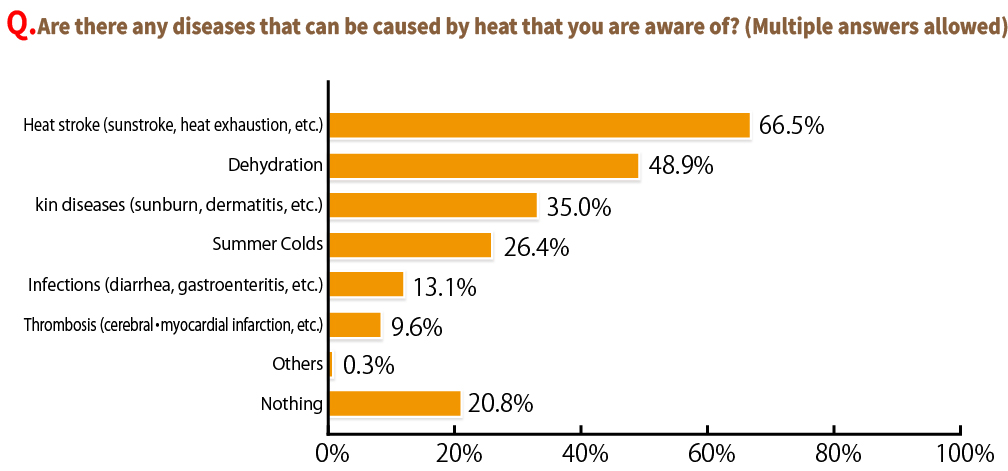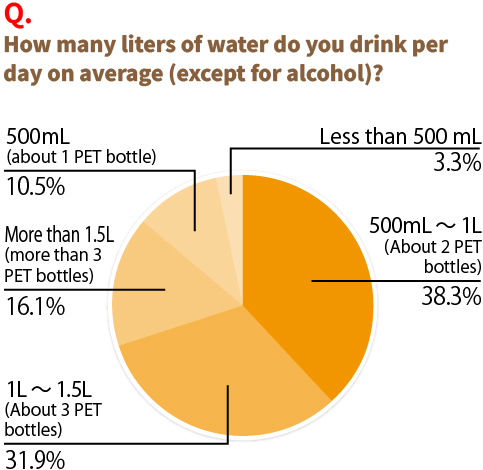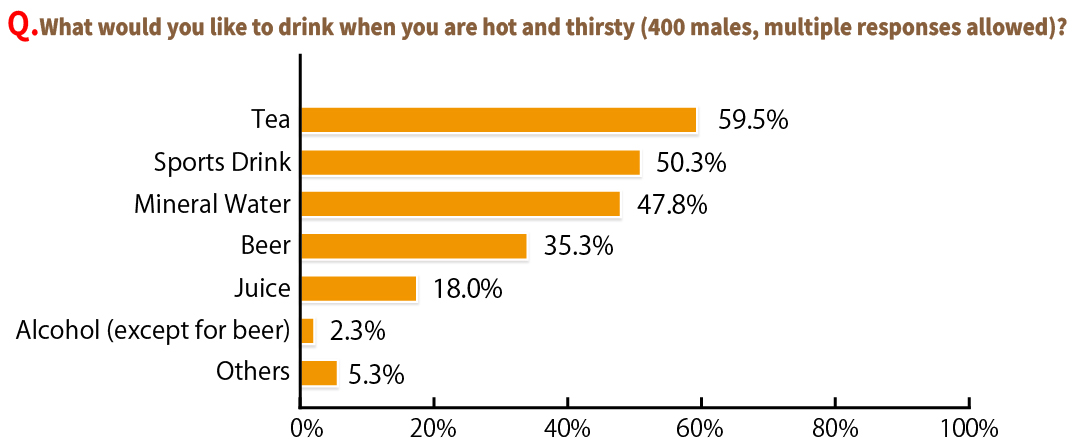
Information
Summer illnesses are not only “heat stroke”! Thrombosis, a disease that about 80% of people associate with winter, is actually dangerous in summer as well!!
A temperature of 32℃ was found to be the ‘‘Tsumaru Deadline’’ where death rates from thrombosis sharply increase!
JNKA conducted a survey of 800 women and men in their 30s to 60s in Japan regarding their general awareness of “thrombosis in summer”
■Survey Results
Beer causes a lack of water in the body, leading to sluggish blood that is vulnerable to thrombus formation! One in three men say they feel the need to drink beer or other alcoholic beverages when they are thirsty!
The top three causes of death in Japan are cancer (malignant neoplasms), heart disease, and cerebrovascular disease, of which myocardial infarction accounts for a large proportion of heart disease and cerebral infarction for cerebrovascular disease. These are caused by “blood clots,” clots of blood that form in blood vessels, and are considered a cause of death on the same level as cancer.
The survey on public awareness of “summer thrombosis” revealed that thrombosis is often associated with winter, and that it is not well known that thrombosis is more likely to occur in summer.
Dr. Atsushi Fukunaga, a neurosurgeon and a certified weather forecaster, says, “brain infarction, which is thought to be more common in winter, actually occurs more frequently in summer as well. The main cause is considered that sweating a lot reduces the amount of water in the blood, which makes it easier for thrombus formation. An overseas study (*1) reported that when the lowest stroke mortality rate was based on average temperatures between 27-29℃, the mortality rate jumped 1.66 times when the average temperature rose to 32℃” and calls for caution against summer blood clots.
In addition, this summer is expected to be warmer than usual, and the effects of saving electricity are expected to result in higher indoor temperatures, so it is necessary to take measures such as frequent rehydration in one’s daily life.
JNKA is conducting educational activities to prevent thrombosis in summer by paying attention to the temperature in daily life and increasing hydration, based on the “Tsumaru Deadline, a temperature of 32℃” that makes it easier for blood vessels to become clogged. The relationship between the risk of thrombosis and temperature has been systematized under the supervision of Dr. Fukunaga and published on this website.
※1 Pan WHet al., Lancet 345: 353-5, 1995
※2 In this text, “thrombosis” includes “cerebral embolism.
! Relationship between risks of thrombosis and temperature
The average value calculated from the “maximum temperature” and “minimum temperature” of the weather forecast is ranked into three levels of danger.
●Hazard Rank
Low Hazard: Average temperature is between 15℃ and 29℃.
Medium Hazard: Average temperature is between 29℃ and 32℃, or between 3℃ and 15℃.
High Hazard: Average temperature is 32℃ or above, or less than 3℃.
*However, if any one of the following conditions is met, the rank will be raised by one rank.
(In the case of high hazard, the rank will not be raised further even if the conditions are met.)
・The maximum temperature is 35℃ or higher.
・The temperature difference from the previous day is 10℃ or more.
・The difference between the maximum and minimum temperature are 10℃ or more.
(Supervisor:Dr. Atsushi Fukunaga, Tachikawa Hospital)
■Survey Result Overview
「The season that comes to mind when one hears the word “thrombosis” was “winter” (81%), compared to only 13% for “summer.” It is not only winter! In fact, “thrombosis” is also a disease of summer.
Only 9% of respondents were aware of “thrombosis.” Heat stroke” (66%) and “Dehydration” (48%) were the most common illnesses people watch out for in the summer!

In addition to heat stroke, there are many other dreaded diseases to watch out for in the summer. In particular, diseases that have a higher incidence in summer include thrombosis (cerebral and myocardial infarctions), dehydration, and skin diseases (dermatitis).
Among these, thrombosis is a disease that requires even greater attention because of its high mortality rate and the possibility of permanent damage. However, thrombosis, such as cerebral infarction, has a strong image of occurring during the cold winter months, and in this survey, those who answered that thrombosis occurs in “winter” (81%) were much more likely than those who answered “summer” (13%) to have this image.
The most common summer illness that people are aware of is heat stroke, which 66% of respondents said they are consciously trying to prevent, while only 9% said they are aware of thrombosis.

84% of people lack enough water to cause summer blood clots!
nly 16% consume more than 1.5 liters of water per day!

It is said that the adult body needs about 2.5L of water per day. Of this amount, approximately 1 L to 1.3 L of water per day can be obtained from food and metabolism. The remaining 1.2 L to 1.5 L must be obtained from beverages. In addition, when you sweat a lot due to heat or exercise, you need to drink extra water than usual. In this survey, only 16% of respondents said they drink more than 1.5 L of water per day, and 84% were found to be insufficiently hydrated.
Especially in summer, blood clots are more likely to develop as the body loses water due to sweating caused by the heat and dryness caused by air conditioners and other cooling devices, and the blood become sluggish.
Beer causes a lack of water in the body, leading to sluggish blood that is vulnerable to thrombus formation! One in three men say they feel the need to drink beer or other alcoholic beverages when they are thirsty!
When asked, “What would you like to drink when you are hot and thirsty?”, 37% of men answered “beer” or “alcohol (other than beer). In summer, quenching your thirst with a cold beer after work or sports may be the ultimate luxury. However, alcohol has a dehydrating effect, and drinking it when thirsty deprives the body of water, making it more prone to thrombosis.

【Survey Outline】
■Area:Throughout Japan
■Survey Method:Web-based quantitative survey using an Internet panel
■Survey Period:May 26 – 27, 2011
■Sample age: 30s – 60s
■Sample gender: Female and male
■Number of samples: 100 persons of each sex and generation, 800 persons in total
※When publishing the results of the survey included in this report, please be sure to clearly state that the survey was conducted by Japan Nattokinase Association.
■Supervisor
【About Dr. Atsushi Fukunaga】
Chief of Neurosurgery, Tachikawa Hospital
As a medical specialist, he noticed the relationship between stroke and “weather”, and got Qualifications on weather forecaster.
As a neurosurgeon and weather forecaster, he provides advice to his patients based on his dual expertise.
He is the author of “Prevent Stroke by Watching the Weather!” (Hekitensha, 2005).
■For inquiries regarding this press conference and media coverage, please contact
Japan Nattokinase Association, Secretariat
pr@j-nattokinase.org
